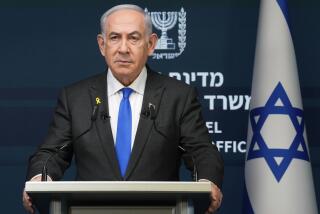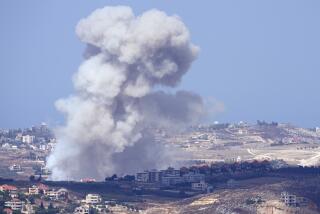Battle of the Peace Talks Talkers
Diplomacy: The designated Israeli and Palestinian spin controllers epitomize the way TV continues to be the primary PR battleground in political warfare between the two sides.
Whether domestically or globally, the telegenic rule the airwaves.
He’s handsome and urbane, speaking articulately in perfect English. He could be your brother, your uncle.
She’s genial and polished, speaking eloquently in perfect English. She could be your sister, your aunt.
However, there’s nothing familial about this week’s Madrid peace talks between Israelis and Arabs. Nor are Benjamin Netanyahu and Hanan Ashrawi as benign as they sometimes appear in front of television cameras.
Netanyahu, 42, is Israel’s deputy foreign minister, a close ally of hard-line Prime Minister Yitzhak Shamir. Perhaps you caught him on CNN Thursday morning taking notes during the address of chief Palestinian negotiator Haidar Abdel-Shafi, then afterward describing it to CNN’s Linda Scherzer as “a speech of confrontation and war.”
A university professor and poet, the 44-year-old Ashrawi is a member of the Palestinian delegation at these preliminary talks that have captured the world’s attention. You could have heard her just about everywhere on TV Thursday reacting to a speech by Shamir that she charged contained “domination, racism and a patronizing attitude.”
As designated spokespersons and spin controllers for their respective delegations, the opposing Netanyahu and Ashrawi epitomize the way TV continues to be the primary public relations battleground in political warfare between the Israelis and Palestinians.
You could have seen them simultaneously Wednesday via videotape on NBC’s “Today” and ABC’s “Good Morning America.” There they were that night in sound bites from Madrid on KABC and KNBC, and there was Ashrawi on PBS, going woman to woman with Charlayne Hunter-Gault of “The MacNeil/Lehrer NewsHour.” Her husband and daughters feared for her safety, she told Hunter-Gault.
Dan Rather interviewed Ashrawi and Netanyahu separately Wednesday on “The CBS Evening News.”
Resting her head on her hand, Ashrawi listened thoughtfully as Rather asked her to describe Shamir’s policy toward Palestinians in the occupied territories. While coolly labeling Shamir’s policy “narrow-minded, short-lived (and) irresponsible,” she smiled.
Cut to Netanyahu, who charged Ashrawi with wanting to have it “both ways” as a moderate and militant, accusing her of making public statements that encouraged the recent surge in Arab terrorism against Israelis.
“These are two decent-intending, articulate people,” Rather concluded afterward.
And, it appears, two very effective PR people.
There’s some tradition here. It was Western TV in the late 1980s, after all, that dramatically widened sympathy for the Intifada--the Palestinian rebellion against Israeli occupation of the West Bank and Gaza Strip--by repeatedly showing pictures of stone-throwing Palestinian youths battling heavily armed Israeli troops. The symbolism--David trying to fend off Goliath--was vivid and persuasive.
And even though the revolt has seemed to slow perceptibly, without its early PR momentum via TV the Bush Administration may not have had enough public support to aggressively lobby Israel to participate in these exploratory talks with Arabs.
No one is saying now that a few strategic sound bites from Netanyahu or Ashrawi will give one side or the other the advantage. Yet the significance of TV can’t be discounted as each wears the face of moderation to gain sympathy for his or her cause.
A former Israeli ambassador to the United Nations with undergraduate and graduate degrees from the Massachusetts Institute of Technology, the charismatic Netanyahu has long been a favorite of network news programs seeking a spokesman for Israel.
A Shamir aide once said of Netanyahu: “He has a very American speaking style--very polished, very fluent, very self-confident and very convincing.” Rarely more so than in the bizarre circumstances of being interviewed by Scherzer in CNN’s Jerusalem bureau during a Scud alert in the early days of the Persian Gulf War. As they spoke, both Netanyahu and his interviewer wore gas masks.
That symbolism was vivid and persuasive.
When Netanyahu argues, as he has in the past, for limiting TV cameras in the occupied territories on grounds that TV is easily manipulated and incites violence, one should not forget his own skillful exploitation of the medium.
A West Bank academician with a doctorate in English literature from the University of Virginia, Ashrawi has also logged a lot of TV time in the West after appearing with Israelis on a “Nightline” town hall meeting from Jerusalem in 1988. She followed that instant fame with a U.S. speaking tour to raise funds for the Palestinian cause.
The images appear fixed: A former paratrooper, Netanyahu combines toughness with reasonableness; Ashrawi mixes sternness with the nurturing presence of a woman with two daughters at home in Ramallah.
Meanwhile, there were TV performers elsewhere. CNN finally got the long-awaited Madrid handshake bite that it and others have been clamoring for when a Palestinian delegate Thursday made a point of clasping the hand of an Israeli parliament member before launching a dialogue with him in English that was obviously tailored for television.
Surely no one expects such symbols and images alone to erode the historic barriers separating Israelis and Arabs. In an age of surprises that has already seen the Berlin Wall tumble and communism in East Europe and the Soviet Union crumble, however, anything now seems possible.
More to Read
Sign up for Essential California
The most important California stories and recommendations in your inbox every morning.
You may occasionally receive promotional content from the Los Angeles Times.









